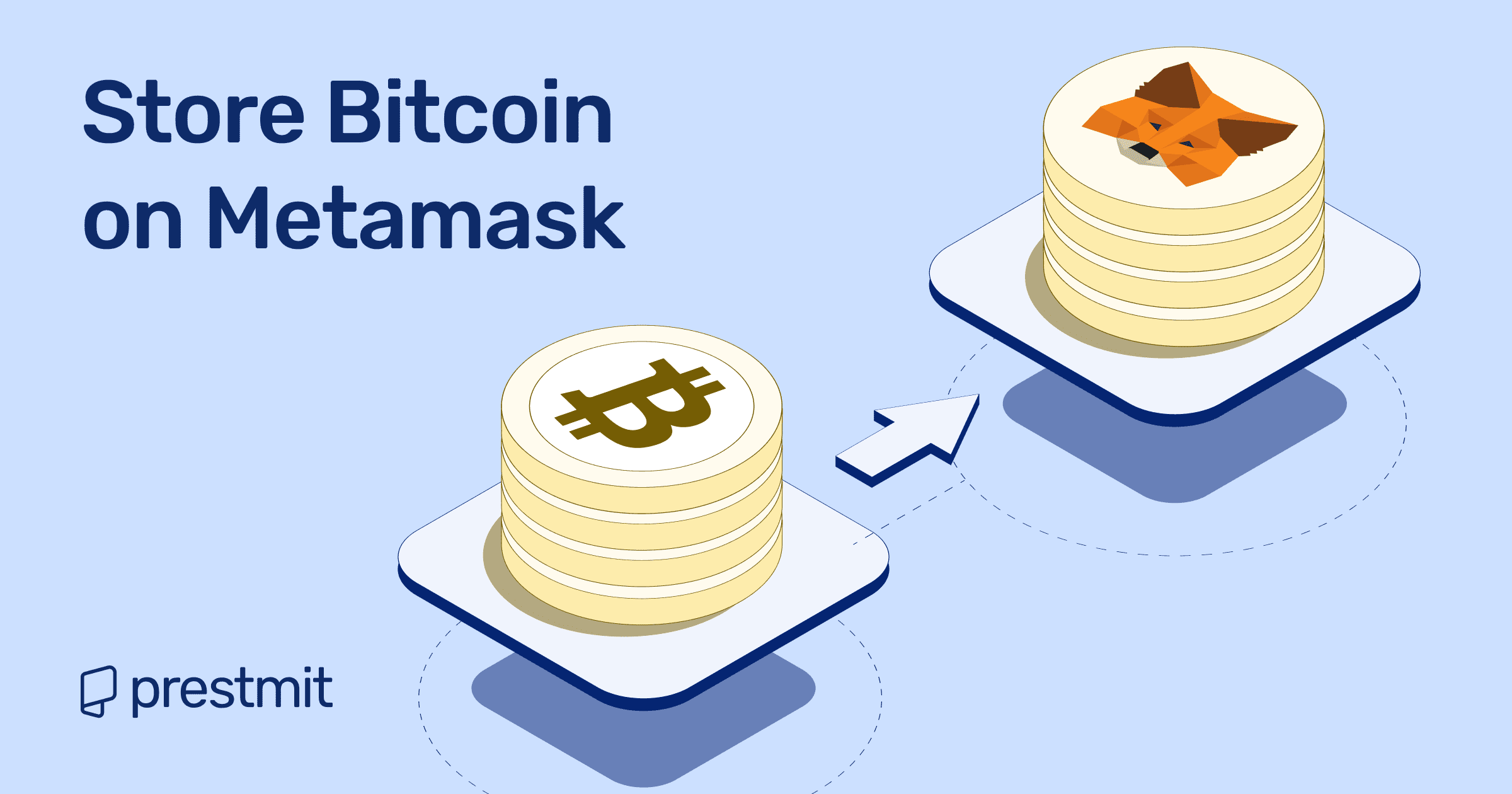Table of Contents
Crypto wallets are designed to store and secure cryptocurrencies from any form of threat. MetaMask is one of the renowned crypto wallets in the world used for Ethereum-enabled distributed applications (DApps). Users can successfully share and use their private keys safely with Ethereum-based DApps and smart contracts on apps.
Bitcoin is a very important asset and means of payment to crypto investors, and as such, stored in digital wallets like MetaMask. Making payments through blockchain technology has become quite easier with the MetaMask crypto wallet.
The MetaMask is an Ethereum-based wallet that allows crypto investors to enjoy all the benefits and participate in all activities of the crypto market.
Even though MetaMask is an Ethereum-based wallet, Bitcoin can be saved in this wallet. However, because Bitcoin is not an ERC-20 token, it is not accepted on MetaMask, though there’s an indirect technique to store BTC in your MetaMask wallet.
Storing or sending Bitcoin to your MetaMask wallet directly may cause some ripple effects which may include losing such Bitcoin.
This article seeks to highlight how one can store Bitcoin in the MetaMask wallet.
What Is MetaMask Wallet?

MetaMask is a cryptocurrency wallet developed by ConsenSys Software Inc., a software blockchain company that deals with Ethereum-based instruments.
MetaMask wallet enables user interaction in the Ethereum blockchain and also, allows them to access their Ethereum wallet either through a browser extension or mobile app which can be further used to interact with decentralised applications(DApps).
Through MetaMask wallets, users can store and manage their private keys, send and receive cryptos and tokens, and connect to decentralized applications (DApps) through the browser or mobile app
There is a feature on the MetaMask application named MetaMask Swaps which is an integrated service for exchanging Ethereum tokens for the best exchange rate by taking the aggregate of numerous decentralized exchanges (DEXs).
How to Store Bitcoin on Metamask
Here are the quick steps to add Bitcoin to MetaMask:
- Download MetaMask (browser extension or mobile app) and create your wallet.
- Save your recovery phrase somewhere safe (write it down or store it).
- Use the Ethereum network (MetaMask is already set to this by default).
- Convert your Bitcoin to Wrapped Bitcoin (WBTC) on an exchange like Binance, Coinbase, or Uniswap.
- Top up your MetaMask with a little ETH (you’ll need this to pay gas fees when sending WBTC).
- Copy your MetaMask wallet address (it starts with “0x”).
- Send your WBTC from the exchange to that address. Only use the Ethereum option when sending.
- Add WBTC to MetaMask: click “Import Tokens” and search WBTC (or paste the official token address).
- That’s it! You’ll see your WBTC in MetaMask, ready to use.
Alternative Wallets to Store Bitcoin
1. Trust Wallet
Trust Wallet supports thousands of coins and tokens, including Bitcoin directly, so you don’t need to go through the wrapping process. It’s mobile-first, easy to navigate, and even packs a built-in dApp browser if you still want to dabble in DeFi without jumping from app to app.
2. Coinbase Wallet
Coinbase Wallet supports Bitcoin directly (no wrapping required) and also connects to dApps like MetaMask does. Think of it as a middle ground: easier for beginners than MetaMask, but still powerful enough to explore DeFi when you’re ready. Plus, if you already use the Coinbase exchange, moving funds in and out will be almost seamless.
3. Exodus
Exodus Wallet is beautifully designed, beginner-friendly, and comes with a built-in swap feature so you can exchange coins without leaving the app. If MetaMask feels a little too crypto-techy, Exodus will feel like the easy-going alternative.
4. Ledger
Ledger is a sleek hardware device that keeps your Bitcoin offline, safe from hackers, malware, and bad Wi-Fi days. It’s slightly less convenient than a mobile wallet, but if you want long-term storage and top-tier security, Ledger is a good option.
5. Electrum
Electrum is the original Bitcoin wallet. It doesn’t try to be flashy; it’s lightweight, fast, and laser-focused on Bitcoin only. Perfect for Bitcoin-only fans who don’t care about NFTs or DeFi, and just want a no-nonsense way to send, receive, and store BTC without distractions.
Is MetaMask For Ethereum Only?
MetaMask wallet is not meant for tokens that are not built on the Ethereum blockchain (non-ERC-20 tokens).
The Ethereum-based tokens (ERC-20 tokens) are best used and stored in the MetaMask wallet, but this doesn’t mean that other non-ERC- 20 tokens can not be used in the MetaMask wallet.
You only have to convert these tokens to ERC-20 tokens before you can store them in the MetaMask wallet.
For example, Zcash is not an Ethereum-based token (non-ERC-20 token) but you can still use Zcash on the MetaMask wallet by wrapping Zcash tokens.
Frequently Asked Questions (FAQs) About Storing Bitcoin on Metamask
Is MetaMask A Hardware Wallet?
MetaMask is not a hardware wallet but it is one of such secure wallets every crypto enthusiast should desire. It’s a software wallet which is also known as a hot wallet that is linked to the internet. However, you can connect MetaMask to a hardware wallet so you can use the MetaMask with the most popular hardware wallet, Ledger.
What happens if I send BTC directly to MetaMask?
If you send BTC directly to a MetaMask wallet address, your BTC will be lost forever with no way to recover it. MetaMask cannot receive Bitcoin on the Bitcoin blockchain. Always convert your Bitcoin to Wrapped Bitcoin (WBTC) before transferring to MetaMask.
Can I swap my WBTC back into normal Bitcoin later?
Yes, you can swap your WBTC back into Bitcoin, but not directly inside MetaMask. To convert WBTC back to BTC, you’ll need to send your WBTC from MetaMask to a crypto exchange that supports WBTC/BTC trading pairs (such as Binance or Kraken). Once you trade it there, you can withdraw the Bitcoin to a native BTC wallet.
Are there fees when using WBTC on MetaMask?
Yes, you’ll pay Ethereum transaction fees whenever you send or trade WBTC. Fees can fluctuate depending on network activity.
Conclusion
The security of your cryptocurrencies is the paramount objective you have as a crypto holder. There are many available crypto wallets both hardware and software that can help you secure your cryptocurrencies from any potential loss or attack.
MetaMask is a great wallet for storing Ethereum-based tokens but it doesn’t limit the storage of Bitcoins in it, as long as the Bitcoin is wrapped (wBTC). Storing Bitcoin directly on the MetaMask wallet is a risk you shouldn’t afford to take.
Last updated on August 21, 2025

